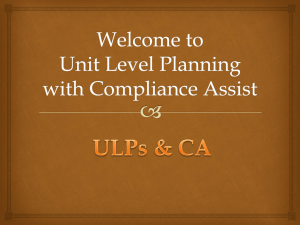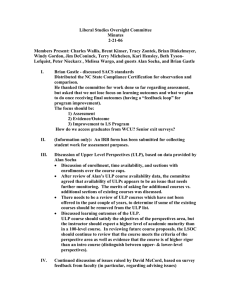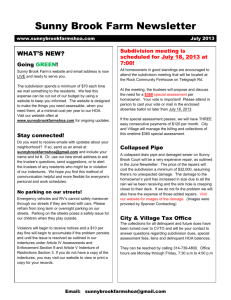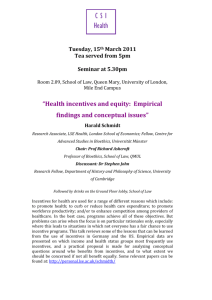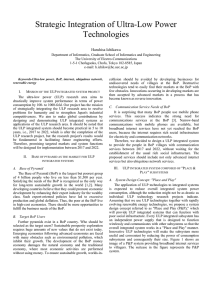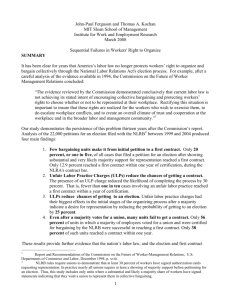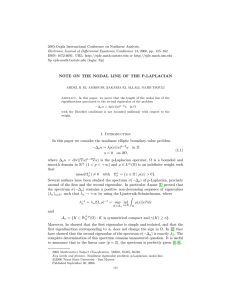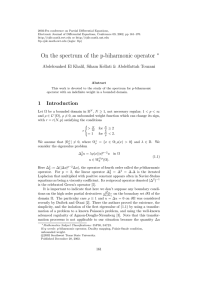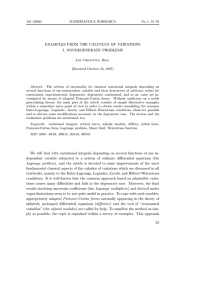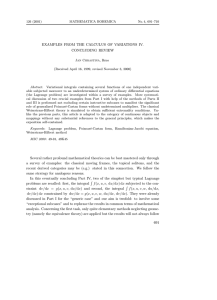UPP558 Land Use Planning Course Outline
advertisement
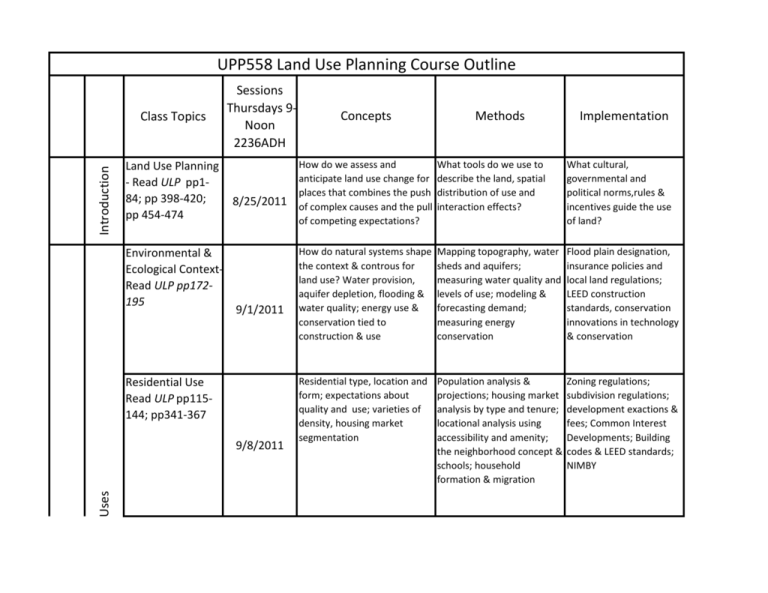
UPP558 Land Use Planning Course Outline Introduction Class Topics Land Use Planning - Read ULP pp184; pp 398-420; pp 454-474 Environmental & Ecological ContextRead ULP pp172195 Sessions Thursdays 9Noon 2236ADH 8/25/2011 9/1/2011 Residential Use Read ULP pp115144; pp341-367 Uses 9/8/2011 Concepts Methods Implementation How do we assess and anticipate land use change for places that combines the push of complex causes and the pull of competing expectations? What tools do we use to describe the land, spatial distribution of use and interaction effects? What cultural, governmental and political norms,rules & incentives guide the use of land? How do natural systems shape the context & controus for land use? Water provision, aquifer depletion, flooding & water quality; energy use & conservation tied to construction & use Mapping topography, water sheds and aquifers; measuring water quality and levels of use; modeling & forecasting demand; measuring energy conservation Flood plain designation, insurance policies and local land regulations; LEED construction standards, conservation innovations in technology & conservation Residential type, location and form; expectations about quality and use; varieties of density, housing market segmentation Population analysis & projections; housing market analysis by type and tenure; locational analysis using accessibility and amenity; the neighborhood concept & schools; household formation & migration Zoning regulations; subdivision regulations; development exactions & fees; Common Interest Developments; Building codes & LEED standards; NIMBY Basic Land Part I Commercial & Retail Use - Read ULP pp145-171; pp315-340 Transport & Infrastructure Read ULP pp228248 Planning Strategies Part II Public Facilities Read ULP pp368398 Smart Growth, New Urbanism & Sustainability Strategies - Read ULP pp249-315 Midterm Exam 9/15/2011 9/22/2011 9/29/2011 Commercial and retail location differences; expectations about location, use & taxes; auto access & parking; type and scale of spatial form (strip, center,…) Commercial and retail market analysis; market areas & transport networks; household purchasing infromation by area; estimating commuting times for employment; evaluating local economic vitality Zoning regulations; development incentives and tax subsidies; TIF districts; BIDs; infrastructure improvements; historic district designtation for aging main streets Street hierarchy and pedestrian walkways; transit system routes and stops; accessibility, mode split and trip generation; traffic analysis & parking; smart streets Mapping transportation infrastructure; using transportation standards for traffic, parking & trips; assessing location transit and auto demand; street transect analysis Mapping facilities & catchment areas; park system network & needs; school enrollment demand & location State road way regulations and local street right of way requirements; traffic system flow requirements; parking and storage regulations; Property tax system, borrowing & bonding; TIF; Fees Elementary and secondary schools; public works; parks; police & fire; city halls; utilities… whew Comparing smart growth, new Comparing land capacity measures, transect urbanism and sustainability concepts for land use planning assessments and ecosystem 10/6/20111 tools 10/13/2011 Comparing conventional zoning with form based code and envrionmental performance indicators lanning Cases art III On the block Learn to judge how private property owner, resident, investor expectations fit changing environmental conditions at the intersection of parcels, streets; and 10/20/2011 changing social conditions as 10/27/2011 households, businesses and investors interact over time Using maps, transects, tables, charts and pictures to compare change over time and to represent expected changes in use against prior or competing uses; prepare a planning brief that identifies problems and offers alternative solutions ; footprints, FAR, massing; Identifying and assessing impacts of current regulations and policies shaping cumulative conditions of block; identifying and selecting policies, regulations or incentives that offer stakeholders or officials means for implementing improvements Along the corridor Consider local stakehlder place goals in relation to visitor passerby goals; Learn to balance the role of streets, sidewalks, stations and stops 11/3/2011 as conduits and places; relate 11/10/2011 catchment areas of demand to local activity nodes; how spatial form, landscape design & streetscape interact Using maps, transects, tables, charts and pictures to show linkage between travel area (commuting & shopping), local attractors and traffic flows in relation to station, stop, ADT, and other flow volumes and types; building footprints & massing; FAR Zoning and code requirements; form based code; development incentives; tax incentives such as TIF; organizational arrangements such as BID; traffic flow changes; transit incentives; parking regulation changes Land Use P Pa Greenfield at the Edge Consider developer municipality trade offs for density, parkland and subdivision design; site topography, ecology and 11/17/2011 development fit; planning commission and elected 12/ 1/2011 official expectations as well as future residents; Municipal Comprehensive Land Use Plan (Response to RFQ) Identify overall municipal goals and relate these with stakeholder interests for specific places and projects; 12/1/2011 12/8/2011 Using maps too configure and compare development footprints; density and spatial form; ecological assessment; market feasibility and impacts on facilities/ schools; traffic flow & connectivity Zoning and subdivision code requirements; form based code; in lieu fees, smart code and new urbanist spatial incentives Frame current plan in relation to prior plan and plans for comparable places; visually identify and describe criteria for private residential development, economic development, public infrastructure, redevelopmetn and environmental enhancement Identify and briefly describe a combination of implementaion strategies that would be appropriate to consider for the client
